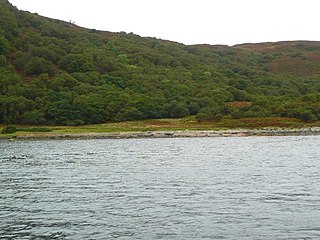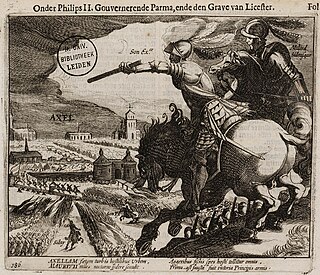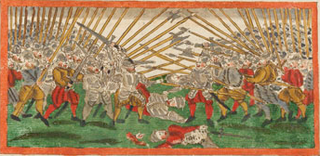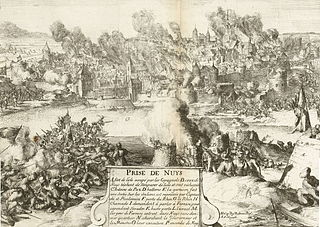 W
WThe Battle of Allt Camhna was a Scottish clan battle fought in 1586 between the Clan Gunn and Clan Mackay against the Clan Sinclair.
 W
WThe Capture of Axel was a military event during the Dutch Revolt and the Anglo–Spanish War in which the town of Axel, defended by the Spanish, was captured by an Anglo-Dutch force led by Sir Philip Sidney, with the garrison being put to the sword. It was also the first feat of Maurice of Nassau.
 W
WThe Battle of Cartagena de Indias (1586) or the Capture of Cartagena de Indias was a military and naval action fought on 9–11 February 1586, of the recently declared Anglo-Spanish War that resulted in the assault and capture by English soldiers and sailors of the Spanish city of Cartagena de Indias governed by Pedro de Bustos on the Spanish Main. The English were led by Francis Drake. The raid was part of his Great Expedition to the Spanish New World. The English soldiers then occupied the city for over two months and captured much booty along with a ransom before departing on 12 April.
 W
WThe Battle of Leckmelm was a Scottish clan battle that took place in 1586, in the Scottish Highlands. It was fought between the Clan Gunn against the Clan Sutherland, Mackays of Aberach and the MacLeods of Assynt.
 W
WThe Battle of Santo Domingo (1586) or the Capture of Santo Domingo was a military and naval action fought on 1 January 1586, of the recently declared Anglo-Spanish War that resulted in the assault and capture by English soldiers and sailors of the Spanish city of Santo Domingo governed by Cristóbal de Ovalle on the Spanish island of Hispaniola. The English were led by Francis Drake and was part of his Great Expedition to raid the Spanish New World in a kind of preemptive strike. The English soldiers then occupied the city for over a month and captured much booty along with a 25,000 ducat ransom before departing on 1 February.
 W
WThe Battle of Zutphen was fought on 22 September 1586, near the village of Warnsveld and the town of Zutphen, the Netherlands, during the Eighty Years' War. It was fought between the forces of the United Provinces of the Netherlands, aided by the English, against the Spanish. In 1585, England signed the Treaty of Nonsuch with the States-General of the Netherlands and formally entered the war against Spain. Robert Dudley, Earl of Leicester, was appointed as the Governor-General of the Netherlands and sent there in command of an English army to support the Dutch rebels. When Alessandro Farnese, Duke of Parma and commander of the Spanish Army of Flanders, besieged the town of Rheinberg during the Cologne War, Leicester, in turn, besieged the town of Zutphen, in the province of Gelderland and on the eastern bank of the river IJssel.
 W
WThe Destruction of Neuss occurred in July 1586, during the Cologne War. Alexander Farnese, Duke of Parma's troops surrounded the city of Neuss, an important Protestant garrison in the Electorate of Cologne. After the city refused to capitulate, Parma's army reduced the city to rubble through a combination of artillery fire, destructive house-to-house fighting, and plundering; during the battle, a fire started that destroyed most of the rest of the city. Approximately 3000 civilians died, out of a population of around 4500, and the entire garrison was killed.
 W
WThe Kyūshū campaign of 1586–1587 was part of the campaigns of Toyotomi Hideyoshi who sought to dominate Japan at the end of the Sengoku period. Having subjugated much of Honshū and Shikoku, Hideyoshi turned his attention to the southernmost of the main Japanese islands, Kyūshū, in 1587.
 W
WThe Battle of Pantelleria (1586) also known as the Fight at Pantalarea was a naval engagement that took place during the Anglo–Spanish War off the island of Pantelleria on 13 July 1586. The encounter was between an English armed merchant fleet of five ships of the Levant Company in convoy under Edward Wilkinson and a fleet of eleven Spanish and Maltese galleys under Don Pedro de Leyva. The English managed to repel all the attacks and returned home unmolested. Although minor the battle had significant consequences in testing English firepower of which was to be used against the Spanish armada two years later when England was under threat of invasion.
 W
WThe Raid on St. Augustine was a military event during the Anglo-Spanish War in which the Spanish settlement of St. Augustine in Florida ) was captured in a small fight and burnt by an English expedition fleet led by Francis Drake. This was part of Francis Drake's Great Expedition and was his last engagement on the Spanish Main before Drake headed north for the Roanoke Colony. The expedition also forced the Spanish to abandon any settlements and forts in present-day South Carolina.
 W
WThe Siege of Grave, also known as the Capture of Grave of 1586, took place from mid-February – 7 June 1586 at Grave, Duchy of Brabant, Low Countries, between the Spanish army led by Governor-General Don Alexander Farnese, Prince of Parma, and the Dutch-States and English forces under Baron Peter van Hemart, Governor of Grave, during the Eighty Years' War and the Anglo-Spanish War (1585–1604).
 W
WThe Siege of Rheinberg 1586–1590, also known as the Capture of Rheinberg of 1590, took place at the strategic Cologne enclave of Rheinberg, one of the principal crossing-points over the Rhine on the stretch between the Electorate of Cologne and the Dutch border, between 13 August 1586 and 3 February 1590, during the Eighty Years' War, the Cologne War, and the Anglo-Spanish War (1585–1604). After an initial siege in 1586, and a long blocking by the Spanish forces until September 1589, Don Alexander Farnese, Duke of Parma (Spanish: Alejandro Farnesio), commander-in-chief of the Spanish army, sent a substantial force, under Peter Ernst, Count of Mansfeld, to besiege Rheinberg. Despite the efforts by Maarten Schenck van Nydeggen, and Sir Francis Vere, to relieve the fortress city, the Protestant garrison finally surrendered to the Spaniards on 3 February 1590.
 W
WThe Siege of Venlo of 1586, also known as the Capture of Venlo, was a Spanish victory that took place on June 28, 1586, at the city of Venlo, in the southeastern of Low Countries, near the German border, between the Spanish forces commanded by Governor-General Don Alexander Farnese, Prince of Parma, and the Dutch garrison of Venlo, supported by relief troops under Maarten Schenck van Nydeggen and Sir Roger Williams, during the Eighty Years' War and the Anglo-Spanish War (1585–1604). After two failed attempts to relieve the city, the siege ended on June 28, 1586, with the capitulation and the withdrawal of the Dutch garrison.
 W
WThe Battle of the Western Isles was a series of conflicts in 1585 and 1586 on the islands of Jura, Islay, Mull and Tiree, Scotland as well as the peninsula of Kintyre on the mainland. However, although the historic sources describe this as having taken place in the "Western Isles" which are now known as the Outer Hebrides, all of the aforementioned locations are actually in the Inner Hebrides. It was fought between the Clan Macdonald of Sleat and Clan MacDonald of Dunnyveg against the Clan Maclean. In 1585, the Macleans slaughtered a party of the MacDonalds of Sleat when they were mistakenly accused of stealing cattle and the MacDonalds of Sleat and Dunnyveg retaliated. James VI of Scotland intervened but the conflicts continued into 1586. After further intervention an Act of Parliament was passed which would levy fines on any clan chiefs who did not maintain peace and good order among their vassals.
 W
WThe Battle of Werl occurred between 3–8 March 1586, during a month-long campaign in the Duchy of Westphalia by mercenaries fighting for the Protestant (Calvinist) Archbishop-Prince Elector of Cologne, Gebhard Truchsess von Waldburg.